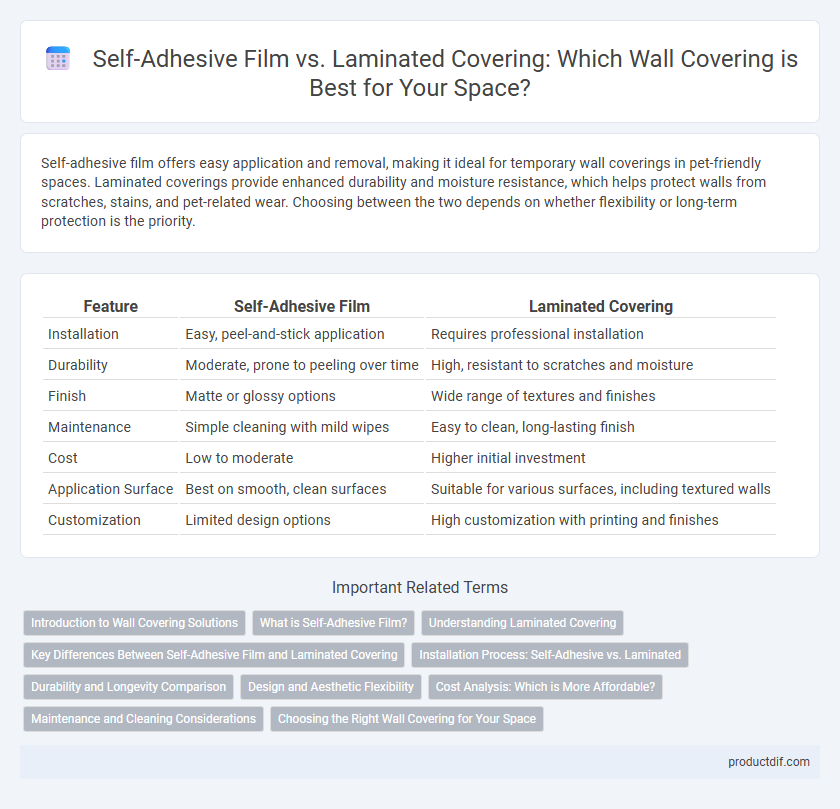Self-adhesive film offers easy application and removal, making it ideal for temporary wall coverings in pet-friendly spaces. Laminated coverings provide enhanced durability and moisture resistance, which helps protect walls from scratches, stains, and pet-related wear. Choosing between the two depends on whether flexibility or long-term protection is the priority.
Table of Comparison
| Feature | Self-Adhesive Film | Laminated Covering |
|---|---|---|
| Installation | Easy, peel-and-stick application | Requires professional installation |
| Durability | Moderate, prone to peeling over time | High, resistant to scratches and moisture |
| Finish | Matte or glossy options | Wide range of textures and finishes |
| Maintenance | Simple cleaning with mild wipes | Easy to clean, long-lasting finish |
| Cost | Low to moderate | Higher initial investment |
| Application Surface | Best on smooth, clean surfaces | Suitable for various surfaces, including textured walls |
| Customization | Limited design options | High customization with printing and finishes |
Introduction to Wall Covering Solutions
Self-adhesive film offers a cost-effective and easy-to-install wall covering solution, featuring a peel-and-stick application ideal for quick renovations and temporary decor changes. Laminated coverings provide enhanced durability and resistance to moisture, heat, and scratches, making them suitable for high-traffic areas and long-term installations. Both options cater to diverse design preferences and functional requirements, with self-adhesive films excelling in flexibility and laminated coverings delivering superior protection.
What is Self-Adhesive Film?
Self-adhesive film is a versatile wall covering material featuring a pressure-sensitive adhesive backing that allows for easy application without additional glue or tools. It comes in various finishes such as matte, glossy, and textured, providing a cost-effective solution for quick wall transformations and surface protection. This film is ideal for DIY projects and commercial use due to its easy peel-and-stick installation, durability, and ability to mimic materials like wood or metal.
Understanding Laminated Covering
Laminated covering consists of a decorative surface layer fused to a substrate, offering enhanced durability, resistance to moisture, and scratch protection compared to self-adhesive films. This type of wall covering is ideal for high-traffic areas and environments requiring long-lasting performance. Unlike self-adhesive films that rely on adhesive backing for application, laminated coverings provide a more robust and damage-resistant finish, ensuring extended aesthetic appeal.
Key Differences Between Self-Adhesive Film and Laminated Covering
Self-adhesive films offer easy application with a pressure-sensitive backing that adheres directly to surfaces without additional adhesives, making them ideal for quick installations and temporary use. Laminated coverings consist of a decorative layer bonded to a substrate with a protective laminate, providing enhanced durability, resistance to scratches, and long-term wear. The key differences lie in their composition, application methods, and durability, where self-adhesive films are more flexible and temporary, whereas laminated coverings ensure a robust, permanent finish suitable for high-traffic areas.
Installation Process: Self-Adhesive vs. Laminated
Self-adhesive film offers a straightforward installation process with an easily removable backing, allowing for quick, bubble-free application on smooth surfaces. Laminated coverings require more precision, often involving adhesive application and additional tools to ensure durability and seamless edges. The choice between self-adhesive and laminated materials impacts installation time, skill requirements, and potential for repositioning during application.
Durability and Longevity Comparison
Self-adhesive films offer moderate durability, suitable for temporary or short-term applications but prone to peeling or fading over time under heavy wear or exposure to sunlight. Laminated coverings provide enhanced longevity with a protective layer that resists scratches, moisture, and UV damage, making them ideal for high-traffic areas and extended use. Investing in laminated coverings ensures sustained appearance and durability, significantly outperforming self-adhesive films in lifespan and maintenance needs.
Design and Aesthetic Flexibility
Self-adhesive films offer unparalleled design versatility with a wide range of textures, colors, and patterns that can be easily customized and replaced, making them ideal for dynamic interior settings. Laminated coverings provide enhanced durability and a high-gloss or matte finish that maintains aesthetic appeal over time, suitable for high-traffic areas requiring long-lasting visual impact. The choice between self-adhesive film and laminated covering depends on the balance between design adaptability and surface protection needs.
Cost Analysis: Which is More Affordable?
Self-adhesive film generally offers a more affordable option compared to laminated covering due to lower material and installation costs, making it ideal for budget-conscious projects. Laminated coverings provide enhanced durability and a premium finish but often come with higher expenses related to manufacturing and professional application. Evaluating project size, desired lifespan, and maintenance requirements helps determine the most cost-effective choice for long-term investment in wall covering.
Maintenance and Cleaning Considerations
Self-adhesive films offer easy maintenance with simple cleaning using mild soap and water, making them ideal for quick, low-effort upkeep. Laminated coverings provide enhanced durability and resistance to moisture and stains, supporting longer-lasting cleanliness in high-traffic areas. Both materials require avoiding abrasive cleaners to preserve surface integrity and ensure longevity.
Choosing the Right Wall Covering for Your Space
Self-adhesive film offers easy installation and cost-effective customization, ideal for temporary or frequently updated wall coverings. Laminated coverings provide enhanced durability, moisture resistance, and a premium finish suited for high-traffic areas requiring long-term protection. Selecting between self-adhesive film and laminated options depends on factors such as exposure to wear, desired lifespan, and maintenance requirements for your specific space.
Self-Adhesive Film vs Laminated Covering Infographic

 productdif.com
productdif.com